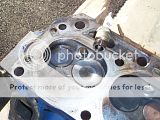WerbyFord":1habsw20 said:
Odd thing is, this article says the 170 head flows 30% BETTER, the data on the CI site would sure disagree with that!
http://www.classicinlines.com/SmallSixSpecs.asp#flow
Yes, both articles are entirely true. read Mike W's information on the posts he made when those flow graphs were drawn up. The cfm flow on the 2V and Classic Inlines is almost the same at the same port each time, but on the log head, the port to port flow rates on log heads vary by 5 to 10 cfm between ports 1 and 6. The combustion chamber improves the cfm flow by creating reduced turbulance in the chamber. This is what David Vizard did in the 70's on 2.0 SOHC Pinto EAO engines, same deal, adding a wall improved cfm flow, removing it reduced cfm. Gettting a 30% cfm increase, and a 1 to 2 point compression ratio increase is a good set of pluses.
Now, the early log had 1.125" ports on the 144,170, and early 200's to about 1965, then Ford started amping up the runner volume to improve both cfm and port to port flow efficency. The ports took on a geoid shape, an elongated, almost D section roofed port which you can see in any of my posts to xrwagon. So the 2v had a 1.625" port, and the intermediate years 1967 to 1983 had an intermediate effective diameter of about 1.3", although it varies. The hole in the log went up from 1.3, to 1.65 to 1.75 in three steps, and then the last of the closed chamber 1971-1972 Mavericks and Cometes had a 170 head had both the larger runners, the better chamber cfm, and better compression, so compared to any similar 200 head,the flow increase cold be even more. Aussie Log a heads from 1968 to 1976 had huge cfm reducing valve stems, including the 1971 to 1973 2v head, so exhaust cfm is less than early small log us heads.
All told, log heads have very poor flow efficiency to each cylinder, and its not hard to get an early 1965 170 chamber head to outflow a later 1981 to 1983 200 log head as the bigger valves shroud the chamber walls, so the flow increase was due to port sizes and the huge hole in the log manifold, not chamber improvements.
Remember, a really good intake manifold flows 85 to 95 % of the bare head with a plastercine bellmouth. But the log head flows much worse, with much less than 75% of the flow of a cut off log, and a well over 5% intake port to intake port flow efficiency change.
WerbyFord":1habsw20 said:
wsa111's little 204cid Gonks to 205hp with the later 77-up big log head so it gets top "Log Head HP/CID" honors, so it seems any of the log heads can be made to run, not like the Alum head but they make a decent showing.

Crosely's 200 Falcon round body does even better...even with this much valve shrouding on his D7 head...
Photo's from my album on the intkae ports are in this post to xrwagon
viewtopic.php?f=1&t=70764&start=50
Gonkulate 15.17 at 87.7 in
Crosely's Falcon
viewtopic.php?f=1&t=56639&p=440076#p440076
or 162.9 rear wheel hp and 198lb-ft of torque in the
Gene Fiore's Maverick, and you'll get about 205 hp. With the 250 cam in the right place, you might see the 217 hp that 162.9 rear wheel hp should be and the 218 hp a worked 250 head can flow.








